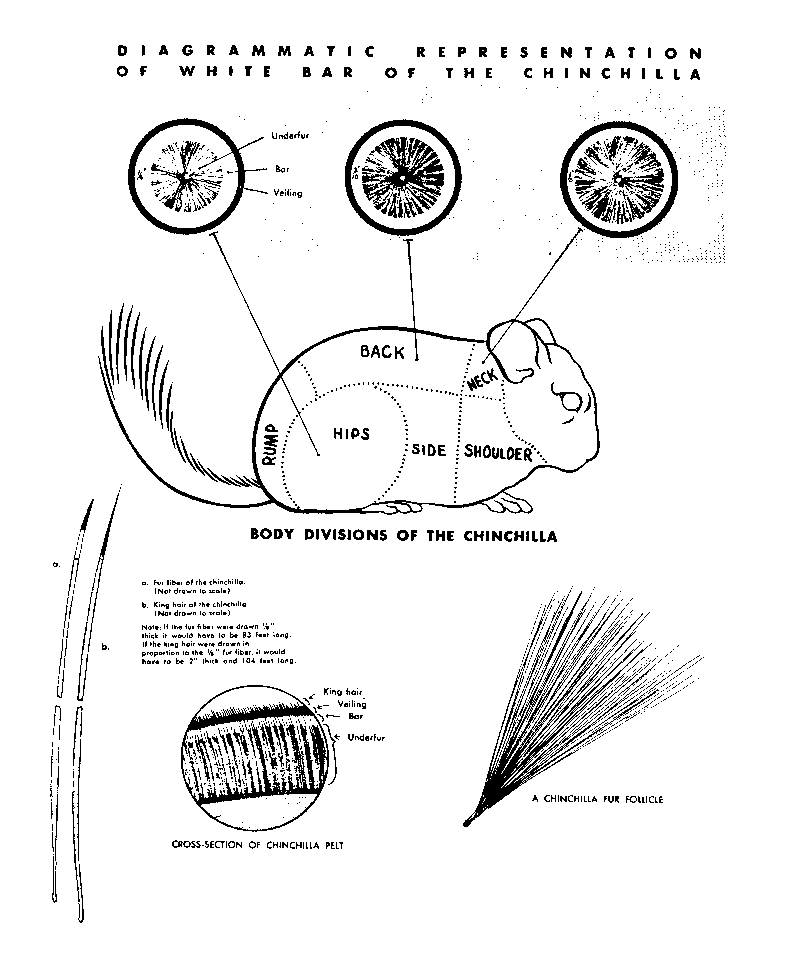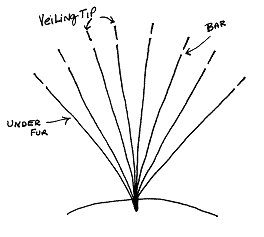|
|
CHARACTERISTICS OF FUR
By Ralph Shoots
To describe a Chinchilla one must comment on all the components that together make up the complete animal. There is nothing more beautiful than a Chinchilla with all qualities as near perfect as possible. That near perfect chinchilla will be a reasonably large, cylindrically shaped, full necked Chinchilla that is Medium Dark – Extra Dark, excellently veiled throughout the neck and gently tapering down the side, and one that is extremely dense or thickly furred. It should also be clear in the bar and belly and blue in the veiling tip. It should have texture that is fine but coarse enough to stand up erect. It should have sufficient fur length to give the animal and pelt a very good cushion. Another characteristic that gives an animal an extra edge in character is a bar that is very distinct. Add all this together and you have a very beautiful Chinchilla.
The following is a breakdown by characteristics to help you understand some of the comments you may hear when animals are evaluated.
SIZE – The easiest to see and most self-explanatory is size. Is it extra-large or very small or where in-between might it fall in respect to its age? In a pelt of course we measure in inches.
CONFORMATION – Next would be conformation. Empress’ definition: It is most desirable when a Chinchilla has a broad, fully furred neck and shoulder area. The body structure is to be reasonably blocky and rectangular.
CLARITY OF COLOR – one must first understand that this does not mean color phase (light, medium, dark, etc.). The clarity of color is judged by the clearness of its color, plus the presence or absence of a distinct impression of blue. Keep in mind that an animal or pelt can be clear but not blue…or blue but not clear. The judges should comment on clarity by telling the ranchers if he is referring to the tip of the animal or the bar and belly of the animal. A rancher cannot make a correction in his breeding program unless he knows where the fault may lie.
STRENGTH OF FUR – The definition of strength of fur is judged by the snap with which it regains its original position after disarrangement. It is the vitality or the resilience of the hair. After a short puff of air is blown in the side – does it snap right back into its original, upright position?
DENSITY – One of the most important qualities is density or volume of fur per given area. As you look at it, it should be very tightly knit and your eyes cannot penetrate below the surface. One lacking in density will have the tips spaced further apart and your eyes can see down the hair shafts sometimes completely to the skin. It takes strength and density to produce ‘cushion’.
LENGTH OF FUR - Another factor with strength of fur and density is becoming very important in producing the very top in pelts. This is length of fur. While too short of fur may make a show animal look very smooth (like a green on a golf course) however it lacks the luxurious cushion. Nothing is more elegant and plush than a dense, long furred animal or pelt.
TEXTURE – When we refer to texture we are referring to the fineness or coarseness of the individual fur fiber. It is the look of softness or silkiness. You may hear a judge break this down further by commenting that an animal is ‘silky’, ‘woolly’, ‘coarse’ or may have a ‘singed’ look to it. Too soft of a texture without good density may cause an animal to have a lay down type of fur or too silky a texture. I can remember years ago hearing a fur broker from New York laughing at us ranchers where we were trying to determine the ‘texture’ of Chinchilla. He reminded us that compared to other furs with obvious differences in texture, when you close your eyes “all Chinchilla has a soft silky texture.”
VEILING – This is the outermost tip of the hair shaft. A Chinchilla fur fiber has three colors. A slate gray underfur – a white bar about a 1/8” wide and an outer most tip that is dark. The contrast between the veiling, bar and underfur is what gives Chinchilla its striking character compared to other furs. While it is beautiful on an animal, complete wrap around veiling down the side is not a must for producing top pelts. However, veiling up through the neck, the naturally weakest part of the pelt, is vitally important. The amount of veiling tip is what determines the color phase of the animal. The longer the tip: the darker the animal. The shorter the tip: the lighter the animal.
FUR PATTERN – Fur pattern is the appearance of the surface of the animal or pelt. Good fur pattern is a smooth, unbroken flow of surface of the fur – like a piece of velvet. When you have swirls, choppiness, a mottled appearance, or any brokenness or unevenness, this is objectionable. Again, a judge should comment on the possible reason for the ‘broken pattern’…is it state of prime, too silky of a texture, lack of density or strength that keeps the fur from standing up, etc?
Other factors that will affect an animal is show condition, state of prime, how clean it was kept, how well it was prepared for the show, etc. An animal way past prime in the neck will take on the appearance of lacking density and veiling there. If a judge comments on these two characteristics lacking, be certain of the state prime. Also, an animal obviously out of prime will not have the brightness of color or strength of fur.

VEILING TIP
+
VEILING COVERAGE =
COLOR PHASE

Veiling coverage is the one thing that IF lacking – even though a pelt or animal may have all other characteristics good can greatly affect the monetary value.
Without veiling coverage a pelt or live animal will lack the character and true beauty of a luxury fur. Texture is linked with veiling coverage – for without veiling coverage a pelt will lack the silkiness and sheen that is most valuable in a pelt. Clarity of color is also linked with veiling coverage. Without veiling coverage the Bar will show through, and if that is not clear the pelt will drop in clarity of color.
Empress Chinchilla
To understand veiling coverage, an understanding of the veiling tip must be achieved.
1. What is the veiling tip?
The veiling tip is the dark section of fur at the very tip of the hair shaft. This should not be confused with Guard Hair.
2. How does the veiling tip affect the color phase of an animal or pelt?
The depth of the veiling tip is an important factor in breeding for darkness and is most often overlooked by ranchers. When there is a long veiling tip the animal will be darker. If there is a short veiling tip then the animal will be of the lighter phases.
3. What is veiling coverage?
On an animal it is the quantity and distribution of the veiling tip; the extent of the evenness of the distribution of the tip. The veiling tip on an animal should extend with the same evenness in the neck area and side area that is has in the center of the back. On a pelt the dark area (center area) is the grotzen and is most important in Chinchilla. The grotzen is nothing more than the concentration of the veiling tip. The more wide and long the grotzen, the more eye appeal it will have, and the more desirable a pelt it is.
|
|
|
|
|
|
|
|
|
Veiling |
|
|
|
|
|
|
|
|
|
|
|
|
|
|
|
|
|
Bar |
|
|
|
|
|
|
|
|
|
|
|
|
|
|
|
|
|
Under Fur |
|
|
|
|
|
|
|
|
|
|
|
|
|
|
|
|
|
|
|
|
|
|
|
|
|
|
|
|
A |
B |
|
Shallow Deep |
|
Tip Tip |
|
|
|
|
|
|
www.shootschinchilla.com
Return to Topics links Home
|
|
|

